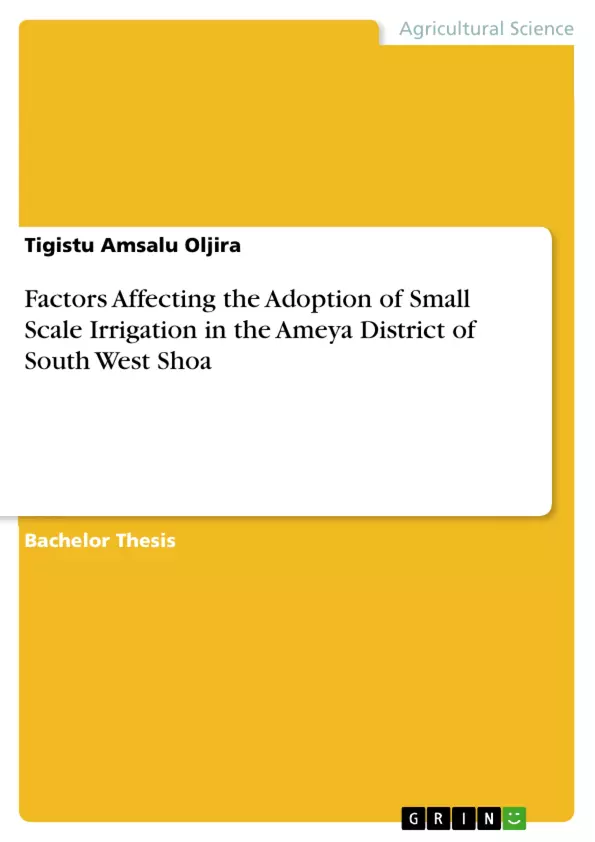The research was intended to answer the following questions:
1. What are the factors impeding adoption of small scale irrigation?
2. What are the problems contributing for less participation of farmers on small scale irrigation?
3. What are possible solutions to improve community participation on irrigation?
Agriculture is the major primary economic activities of the Ethiopian population. Due to the existence of diversified topography, soil, weather and climatic conditions that favor agricultural activities the majority of the Ethiopian population have been engaged in and generate their income from the sector.
However, agriculture in Ethiopia is mainly characterized by the use of backward & traditional farm implements and subsistence farming system dominates by rain fed agricultural production that resulted to low and declining productivity of the sector. The use of supplementary irrigation from either traditional or modern water harvesting structures is considered by the government.
Inhaltsverzeichnis (Table of Contents)
- Acknowledgements
- List of Tables and Figures
- List of Annexes
- Acronyms (Abbreviations)
- Introduction
- Background
- Statement of the Problem
- Objectives of the study
- Research Questions
- Significance of the Study
- Review of Literature
- Definition of Concepts
- Small Scale Irrigation
- Methodology
- Background of the study area
- Research Design
- Sampling techniques
- Methods of Data collection & source of relevant data
- Method of Data analysis
- Results and Discussion
- Summary of Background Information of Sample Farmers
- Access to media & Source of Agricultural information of the sample farmers
- Impact of Irrigation on living status of sample farmers
- Attitude of sample farmers towards development of the scheme & their condition on using irrigation
- Major constraints that were hindering the sustainable use of irrigation Scheme
- Conclusion & Recommendations
- Conclusion
- Recommendations
- References
Zielsetzung und Themenschwerpunkte (Objectives and Key Themes)
This research report examines factors influencing the adoption of small-scale irrigation in the Ameya District of the South West Shoa Zone, Oromiya Regional State, Ethiopia. The study focuses on the Kulit Small Scale Irrigation Project, aiming to understand the factors hindering its sustainable utilization and impacting the livelihoods of local farmers.
- Impact of small-scale irrigation on the livelihoods of farmers
- Factors influencing the adoption and utilization of irrigation schemes
- Constraints hindering the sustainable use of irrigation projects
- The role of access to information and agricultural extension services
- Farmers' attitudes and perceptions towards irrigation development
Zusammenfassung der Kapitel (Chapter Summaries)
The research report begins with an introduction that establishes the background, objectives, and significance of the study. The literature review explores the definition of small-scale irrigation and its impact on rural development. The methodology section outlines the research design, sampling techniques, data collection methods, and data analysis procedures employed in the study. Chapter 4 presents the findings of the research, analyzing data related to the socio-economic characteristics of the sample farmers, their access to information, the impact of irrigation on their livelihoods, their attitudes towards the irrigation scheme, and major constraints hindering its sustainability. The conclusion summarizes the main findings and draws implications for policy and practice. The report concludes with recommendations for improving the effectiveness and sustainability of small-scale irrigation projects in the region.
Schlüsselwörter (Keywords)
The key focus of this research report lies in understanding the factors influencing the adoption and sustainability of small-scale irrigation in Ethiopia. This encompasses the assessment of farmer perceptions, constraints, and the impact of irrigation on livelihoods. The report leverages empirical data collected through surveys and interviews, exploring themes such as agricultural extension, information access, farmer participation, and sustainable development practices.
- Quote paper
- Tigistu Amsalu Oljira (Author), 2008, Factors Affecting the Adoption of Small Scale Irrigation in the Ameya District of South West Shoa, Munich, GRIN Verlag, https://www.grin.com/document/301441



